Synergistic interfacial and radical strategy enables boosted near-neutral selective photoelectrochemical alcohol oxidation
IF 6.5
1区 化学
Q2 CHEMISTRY, PHYSICAL
引用次数: 0
Abstract
Photoelectrochemical (PEC) systems hold great potential for producing value-added chemicals through the selective oxidation of alcohols in an environmentally friendly manner. However, previous efforts have been hindered by low quantum efficiency, poor selectivity and instability of the photoanodes. To address these issues, we demonstrate the oxidation of benzyl alcohol (BA) into benzaldehyde (BAD) with state-of-the-art efficiency and selectivity using CdS photoanodes incorporated with gold nanoparticles as catalytic sites and sulfites which allow the photoanode to operate through a radical process in near-neutral conditions. This synergistic approach allows the typically vulnerable CdS-based photoanode to maintain PEC Faradaic efficiencies exceeding 95 % for BAD production over 20 h with >99 % selectivity (at pH 9 and 0.6 V versus RHE). The Au-SO32− adduct, formed by the strong adsorption of sulfite replacing traditional oxygen/hydroxyl species on the CdS surface, actively catalyzes the selective oxidation of BA. This novel PEC pathway offers a sustainable approach for organic molecule conversion and provides a model for designing efficient PEC processes for solar energy utilization.


协同界面和自由基策略促进近中性选择性光电化学醇氧化
光电化学(PEC)系统具有巨大的潜力,可以通过对醇的环境友好的选择性氧化来生产增值化学品。然而,由于光阳极的量子效率低、选择性差和不稳定性,以往的研究一直受到阻碍。为了解决这些问题,我们展示了以最先进的效率和选择性将苯甲醇(BA)氧化成苯甲醛(BAD),使用含有金纳米颗粒作为催化位点的CdS光阳极和亚硫酸盐,这些亚硫酸盐允许光阳极在接近中性的条件下通过自由基过程操作。这种协同方法允许典型的脆弱的基于cd的光阳极在20 h以上的BAD生产中保持超过95 %的PEC法拉第效率,并具有 >;99 %的选择性(在pH 9和0.6 V相对于RHE)。亚硫酸盐对Au-SO32−的强吸附取代了cd表面传统的氧/羟基,形成Au-SO32−加合物,积极催化BA的选择性氧化。这种新型的PEC途径为有机分子转化提供了可持续的途径,并为设计高效的PEC工艺以利用太阳能提供了模型。
本文章由计算机程序翻译,如有差异,请以英文原文为准。
求助全文
约1分钟内获得全文
求助全文
来源期刊

Journal of Catalysis
工程技术-工程:化工
CiteScore
12.30
自引率
5.50%
发文量
447
审稿时长
31 days
期刊介绍:
The Journal of Catalysis publishes scholarly articles on both heterogeneous and homogeneous catalysis, covering a wide range of chemical transformations. These include various types of catalysis, such as those mediated by photons, plasmons, and electrons. The focus of the studies is to understand the relationship between catalytic function and the underlying chemical properties of surfaces and metal complexes.
The articles in the journal offer innovative concepts and explore the synthesis and kinetics of inorganic solids and homogeneous complexes. Furthermore, they discuss spectroscopic techniques for characterizing catalysts, investigate the interaction of probes and reacting species with catalysts, and employ theoretical methods.
The research presented in the journal should have direct relevance to the field of catalytic processes, addressing either fundamental aspects or applications of catalysis.
 求助内容:
求助内容: 应助结果提醒方式:
应助结果提醒方式:


